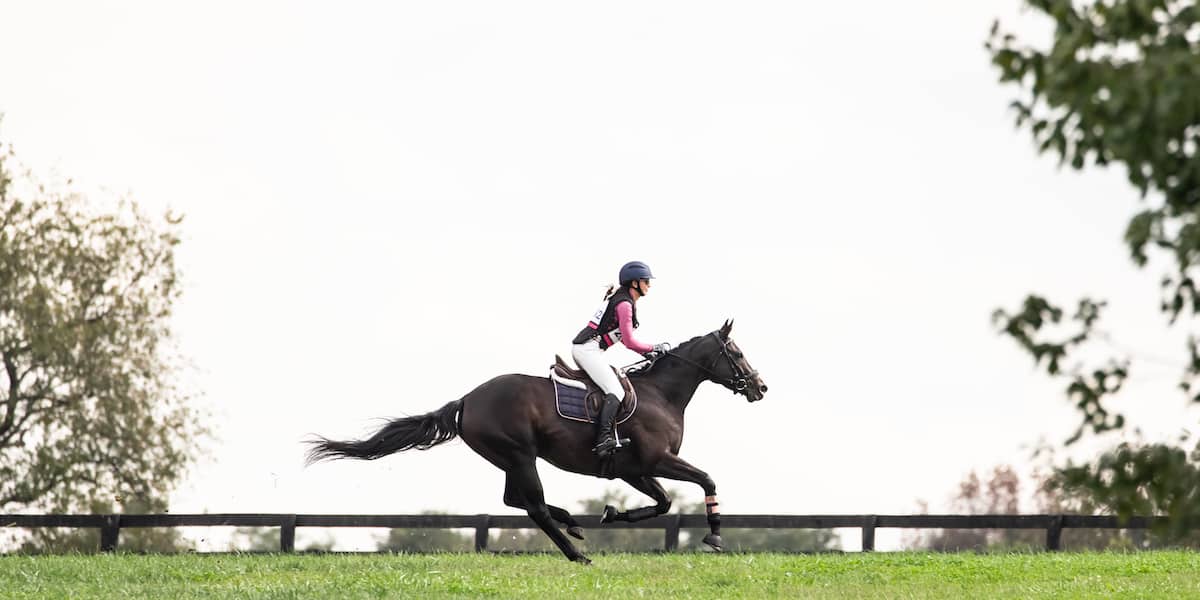Many riders hail Thoroughbreds as the safest steeds cross-country; is there truth to this claim?

Courtesy Bethany P Photography
Cross-country is eventing’s hallmark. It’s exhilarating for riders and spectators alike as horses gallop across varying terrain, splash through water, and soar over fences. Unfortunately, it can also be dangerous.
As with any horse sport, we can’t eliminate all risks or injuries. However, riders can take steps to reduce the likelihood of falls or other accidents on cross-country: Compete at an appropriate skill level, know when to call it a day if you and/or your horse aren’t performing up to par and make smart riding choices while on course. But first and foremost, select a safe cross-country mount.
Some have said Thoroughbreds are uniquely suited for cross-country. You only have to look so far as social media to see retired racehorses as the choice ride of professionals, amateurs and juniors alike. Let’s take look at the qualities that make many riders consider OTTBs the safest cross-country horses around.
Build, Athleticism and Brain
Susan Johns, DVM, CVA, a sports medicine veterinarian at Virginia Equine Imaging, in The Plains, and head veterinarian for the U.S. eventing team, has competed to the CCI* level and knows eventers inside and out — literally. She says it’s her experience that Thoroughbreds possess certain physical and mental characteristics “that make them especially proficient at eventing.”
For starters, “a good event horse will have the ability to gallop and jump for extended periods of time over challenging obstacles on unpredictable terrain,” she says. “An event horse should give the appearance that they can gallop all day long across the landscape. They need a well-balanced body and strong hindquarters for maximum power and stability for navigating imposing obstacles at speed.”
They should be capable, versatile and scopey. Johns says an excellent jump is “of paramount importance” to keep an upper-level event horse and his rider safe as they navigate increasingly difficult courses; horses with average jumping ability can find success at the sport’s lower levels (training and below).
She adds that good feet and conformation are also important.
“Conformational traits such as limb length and joint angulation allow the horse to gallop efficiently,” she says. Horses with an inefficient gallop can tire more rapidly, potentially leading to fatigue-related falls or injuries.
Veteran eventer and trainer Corinne Ashton, who splits her time between Princeton, Massachusetts, and Aiken, South Carolina, trained and competed her unraced Thoroughbred Dobbin to the CCI**** level. She now enjoys starting recently retired racehorses in eventing and reselling them, along with competing her own OTTBs. She says another important trait for an event horse to have is a good mind, and Johns agrees.
“A horse’s mind and willing and tolerant attitude make them excel in the sport of eventing,” Johns says. “Good event horses are strong multitaskers. They need to be calm and focused for dressage, bold yet adjustable for cross-country and sharp and careful for show jumping.”
Ashton adds that a degree of self-preservation benefits event horses, as well. A horse can be more than willing to jump over, into or out of anything you point him at, she explains, but one with self-preservation instinctively knows to when to say no. This is not the notorious “dirty stopper” or the horse that repeatedly refuses a ditch or water jump, for instance. Rather, it’s the horse that stops because something’s not right, such as deteriorating footing that’s preventing a balanced approach or takeoff, or a poor approach that affords no opportunity for the horse to evaluate the question.
“Like people, horses are born with a certain disposition, which can, of course, be helped with correct training, exposure and experience,” she says. Still, safe and successful event mounts should have a good mind on which training can build.
On the whole, Thoroughbreds have many of the innate traits Ashton and Johns describe: They’re born to run, tend to be good jumpers, thrive on work and typically want to please.
Adds Johns, “For lower-level horses, the mind and willingness to perform may overcome some manageable soundness issues.” Remember that even some Thoroughbreds coming off the track with injuries could make safe and rideable cross-country mounts if they have the ideal mind; just work with your veterinarian to be sure your horse’s body can withstand the level at which you intend to compete.
Conditioning and Training
Of course, the horse’s conformation and agility aren’t the only considerations for a safe cross-country mount.
“Eventers come in a variety of shapes and sizes and are not restricted by breed,” says Johns. “However, Thoroughbreds and Thoroughbred-crosses appear to dominate the sport because of their speed and endurance. Going cross-country seems to come very naturally to this breed.”
Says Ashton, “Thoroughbreds are born athletes. They inherently want to run, and they find galloping very easy.”
Of course, she cautions, some ex-racehorses prefer to go faster than is safe (or, especially at the lower levels, allowed) for a particular course. This simply makes training and preparation all the more important. Teaching a horse to both move out and come back to the rider can go a long way toward keeping the exceptionally keen Thoroughbred safe on cross-county.
Also, Thoroughbreds tend to gain condition quickly compared to some other breeds — a benefit in a sport that requires a fit horse to compete safely — but riders and trainers should still ensure they’re well-prepared before taking to the cross-country course.
Even the most conformationally correct, scopey and efficient horse must be conditioned properly for his competition level, and that responsibility lies with the rider and trainer.
“Insufficient preparation may cause the horse to lose energy and confidence over the fences,” says Johns. “If a horse is pressed beyond their physical abilities, they are more likely to sustain an injury.”
Ashton adds that especially at the lower levels, proper condition helps a horse — maybe even one that lacks the ideal eventing physique — become a better cross-country mount by readying his body for the task at hand.
Additionally, to be safe on cross-country, horses must be ready for any obstacle they might encounter at a specific level. This comes easy for many Thoroughbreds, Ashton says, thanks to their bold, observant and typically careful nature.
Preparing horses for cross-country courses involves exposing them to water, ditches and banks, she says, “all over undulating terrain. Downhill and uphill terrain make a single fence completely different obstacles.”
Of course, there’s no way to completely avoid the surprise of a new or particularly “scary” obstacle at a competition. But showing them a variety of obstacles ahead of time (and ensuring he clears them safely) can help reduce the likelihood of a spook, stop or fall at an unfamiliar fence.
Ashton says it’s been her experience that Thoroughbreds’ brains work very rapidly, and they’re quicker to move their legs and feet than other breeds, traits she says can help them get out of sticky situations easier than slower-moving horses.
“The downside is sometimes their quick movement can cause the rider to dismount sooner than expected,” she concedes with a laugh.
The Bottom Line
There are no statistics to prove that a Thoroughbred (or any breed, for that matter) is the safest horse to ride cross-country. But Ashton and Johns agree that, on a whole, the breed embodies many of the characteristics of a good cross-country horse.
“It is the individual’s responsibility to choose the most suitable possible mount to either compete on themselves or have their students or their kids ride,” says Ashton. “People need to be educated that it is not really how pretty and big a horse is that makes him safe — and fun — to ride cross-country.” Also important for safety is competing at levels appropriate to the horses’ and riders’ physical or mental abilities.
Thoroughbreds, like all eventers, must be properly trained and conditioned and sound enough for the job to be safe and satisfactory mounts. But when you find an “OTTB unicorn”, you’re in for the ride of your life.
“My favorite kind of horse to ride across country is one that is calm enough that he’s easy to ride and steer, yet interested enough to want to go, and quick enough to literally think on his feet,” says Ashton. “I haven’t managed to find that in anything other than a Thoroughbred.”
This article was originally published in the Spring 2018 issue of Off-Track Thoroughbred Magazine, the only publication dedicated to the Thoroughbred ex-racehorse in second careers. Want four information-packed issues a year delivered to your door or your favorite digital device? Subscribe now!

